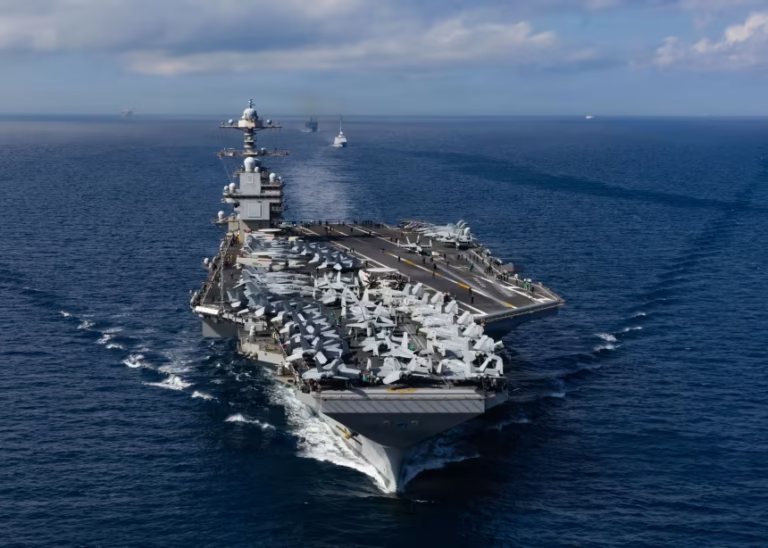The United States has deployed its most advanced aircraft carrier, the USS Gerald R Ford, to the Caribbean as part of increased military pressure on Venezuela over alleged drug trafficking. The move marks a significant show of strength by the Trump administration in a region that has become a focal point of US security concerns.
Described by the US Navy as “the most capable, adaptable, and lethal combat platform in the world,” the USS Gerald R Ford represents the peak of American naval technology. With a displacement exceeding 100,000 tons and stretching 1,100 feet in length, it is the largest warship ever built by the United States.
Commissioned in 2017, the Ford is the first of a new class of aircraft carriers designed to replace the Navy’s aging Nimitz-class vessels. The ship carries a crew of nearly 4,600 personnel, including its air wing—around 20% fewer than the older class, thanks to its highly automated systems and streamlined operations.
According to Navy officials, the Ford’s efficiency and power come from its two next-generation nuclear reactors. While the exact technical details remain classified, these reactors produce roughly three times the electrical output of those on Nimitz-class carriers. This added power allows the ship to support new technologies, such as the Electromagnetic Aircraft Launch System (EMALS), which replaces traditional steam catapults.
The EMALS uses magnetic energy to launch aircraft more quickly and with heavier payloads, giving fighter jets greater range and firepower. The ship also features 11 Advanced Weapons Elevators powered by electromagnetic motors instead of hydraulics. These systems enable faster movement of munitions from the storage decks to the flight deck, increasing readiness during combat operations.
Another major innovation is the Advanced Arresting Gear, a digitally controlled system that helps recover aircraft after landing. It uses precise energy absorption to handle a wider range of aircraft safely and efficiently, reducing maintenance needs while boosting sortie rates.
The Ford’s flight deck is slightly wider than that of its predecessors, with a redesigned “island” structure that sits farther back, providing more operational space for aircraft handling and maintenance. These improvements collectively make the Ford the most advanced and flexible carrier in the world’s navies.
The heart of the Ford’s strike capability lies in its air wing, led by F/A-18 fighter jets. These twin-engine aircraft can carry a wide range of missiles and precision-guided bombs, with a maximum combat range of about 1,250 miles. The carrier also supports electronic warfare aircraft, early warning planes, cargo transports, and helicopters, expanding its operational reach.
However, the Ford currently does not support the Navy’s newest stealth aircraft, the F-35C. The necessary upgrades to accommodate the fifth-generation fighter will be made during a future maintenance phase.
Bringing the Ford to full operational status was a long process. After its commissioning in 2017, technical challenges delayed its first deployment for nearly five years as engineers worked to resolve issues with its new systems. The carrier finally completed its first deployment in 2022, followed by its first combat mission in 2023.
During that mission, the Ford operated in the eastern Mediterranean following the Hamas-led attacks on Israel, supporting regional stability operations. Its new deployment to the Caribbean is expected to play a similar role — reinforcing US naval presence, deterring illicit activity, and signaling Washington’s commitment to countering transnational threats.
Military analysts say the deployment sends a strong political and strategic message. It not only enhances the US’s operational reach in the Western Hemisphere but also underscores its readiness to respond rapidly to potential crises involving Venezuela or regional drug trafficking networks.
The USS Gerald R Ford’s presence is part of a broader US effort to maintain maritime security and project power across key global regions. As tensions rise in the Caribbean, the world’s largest and most advanced warship stands as a reminder of the US Navy’s technological edge and enduring influence.







